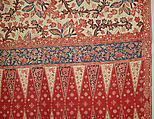Sarong (Kain Lepas)
Not on view
Women’s skirts are made in two basic formats: wrappers (kain panjang), long rectangular cloths, with two free ends, that are wrapped around the body, and tubular skirts (sarung), shorter rectangular textiles in which the ends are sewn together to form a tubular garment that is pulled up and secured around the waist. Created in a batik workshop on the north coast of central Java, this sarung has been opened up so that the complete design can be seen. Until the mid-nineteenth century, only free women were permitted to wear kain panjang, while slaves wore sarung.
On the north coast, the design of sarung reinforced this social distinction. There, most sarung and kain panjang are traditionally divided into two sections: the "body" (badan) and a broad vertical band called the "head" (kepala). While in kain panjang and some sarung the kepala appears at one end of the cloth or is split into halves, one at either end, in the sarung worn by slaves the kepala was placed, as here, at the center. Following the abolition of slavery in 1860, women of every rank began to wear sarung in all formats as casual garments. Although it has the central kepala once prescribed for slaves, this finely crafted sarung was intended for an affluent buyer. The floral patterns in this badan are based on designs from trade textiles from India, while the small red phoenix and qilin (fantastic scaly four-legged animals) in the kepala are of Chinese origin. Sarung in this style were fashionable among women in north coast Chinese communities, many of whom were batik makers, so this skirt may have been created by, and intended for, a woman of Chinese descent.
This image cannot be enlarged, viewed at full screen, or downloaded.
This artwork is meant to be viewed from right to left. Scroll left to view more.



